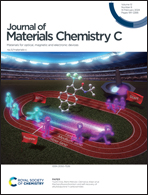Rationalizing the carborane versus phenyl-driven luminescence in related dicarboxylic ligands and their antenna effect for their Eu3+ and Tb3+ metal–organic frameworks: a combined experimental and computational study†
Abstract
Replacement of a phenyl moiety by a carborane in 1,3-di(4-carboxyphenyl) derivatives has a pronounced effect on the photophysical properties of the compounds themselves and their corresponding Eu3+ and Tb3+ metal organic frameworks. Herein, we demonstrate that while the luminescence of the carborane-derivative 1,7-di(4-carboxyphenyl)-1,7-dicarba-closo-dodecaborane (mCB-L) is negligible in the solid state (0.3%), the corresponding phenyl-derivative [1,1′ : 3′,1′′-terphenyl]-4,4′′-dicarboxylic] (TDCA) is highly luminescent (quantum yield of 47.8%). However, the latter one is a much worse antenna for sensitizing Eu3+ and Tb3+ cations than the former one. Based on our previous studies where mCB-L behaves as a good antenna for these two lanthanides, we have now comparatively studied the optical properties of mCB-L and TDCA and their efficiency as sensitizers for Eu and Tb cations, in the solid state at room temperature. STEOM-DLPNO-CCSD calculations revealed a larger energy difference between the singlet S1 and the lowest conical intersection (CI) points for TDCA (33.0 kcal mol−1) than that for mCB-L (18.4 kcal mol−1), explaining the observed different luminescence properties of these two compounds. Contrary to the carborane derivative, TDCA exhibits a more distorted structure at the CI point. TDCA-Eu and TDCA-Tb MOFs have been synthesized and characterized by infrared spectroscopy (IR) and powder X-ray diffraction (PXRD). The optical properties of TDCA-Eu and TDCA-Tb MOFs were investigated, and both MOFs displayed luminescence in the visible region with characteristic emission bands attributed to Eu3+ and Tb3+ transitions, respectively. However, the quantum yields for TDCA-Ln (Eu, 11.1%; Tb, 4.8%) were found to be much lower than those of carborane-based MOFs (Eu, 20.5%; Tb, 49.8%), indicating that the TDCA ligand is a less efficient light-absorbing sensitizer for Eu3+ and Tb3+ ions compared to the carborane-based ligand and may favor undesired back-energy transfer, as suggested by their faster decay times in comparison with the carborane counterparts. STEOM-DLPNO-CCSD calculations are used to analyze the changes in electron densities on photo-excitation from S0 to S1 and de-excitation from T1 to S0, as well as the differences in the excited state energies for mCB-L, TDCA, and the hypothetical longer derivatives (mCB-L2 and QDCA). Our research, which combines experimental and computational methods, offers valuable data for optimizing the singlet and triplet energies, as well as their differences (gaps), by choosing between phenyl and carborane as the building scaffold for 1,3-di(4-carboxyphenyl) compounds. This demonstrates that using phenyl or m-carborane as the building scaffold leads to distinct luminescence properties.



 Please wait while we load your content...
Please wait while we load your content...